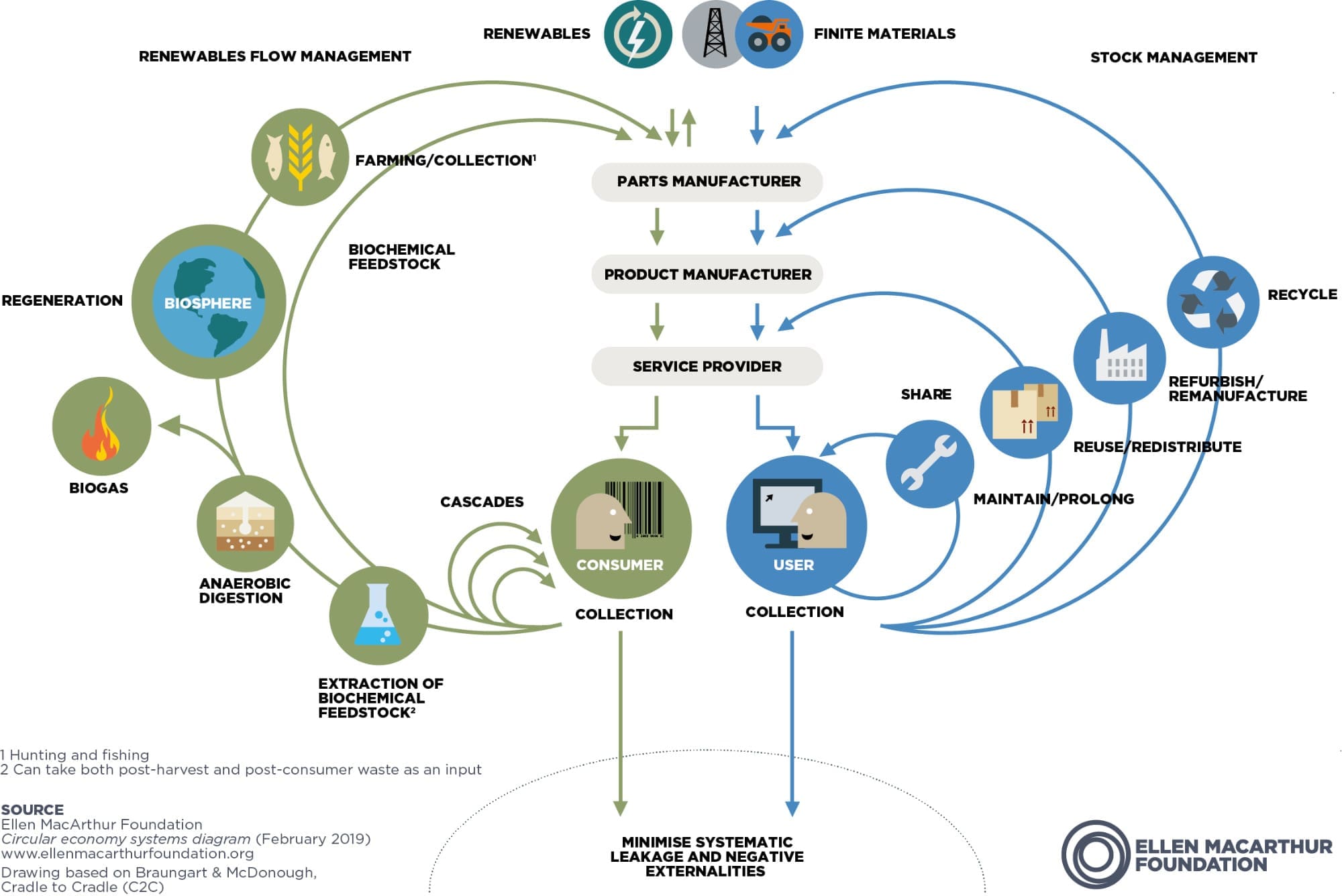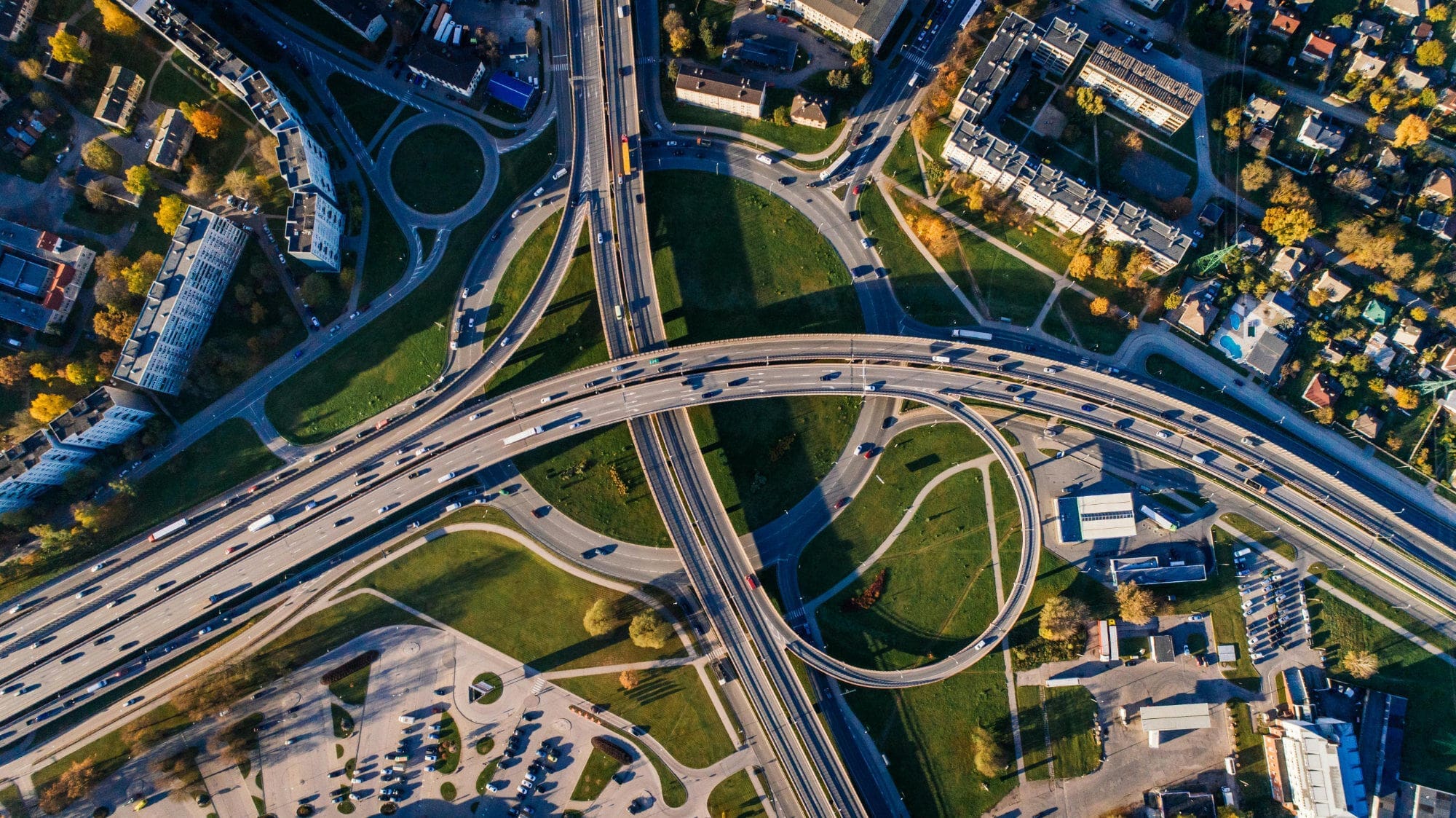What is the circular economy (not)?
Many people believe that the circular economy, sometimes referred to as ‘circularity’, is no more than recycling, but it is a much bigger idea than that. In the conventional sense, circularity is about a profound redesign of global economic and material flows. With the aim of ensuring that products are used more effectively, and for longer. And that when a product is made, it is done so with little or no detrimental impact to the environment. Thereby reducing or eliminating waste.
At its core, circularity is a rethink of our current economic operations, challenging the traditional linear models that focus on ‘take-make-waste’. It advocates for a system where resources are not merely consumed, but are continuously cycled back into the economy, maintaining their value indefinitely. This model doesn’t just tweak the existing system, it overhauls it to foster long-term sustainability and resource efficiency. Creating growth that is restorative and regenerative, rather than consumptive and extractive.
Why is accelerating circularity so important?: what advantages does it offer?
The clue is ultimately in the name, circular ECONOMY. It is about unlocking new and different opportunities, and can therefore be considered a framework to achieve the broader sustainability agenda. With its three main principles contributing significantly to wider goals:
1. Eliminate waste and pollution.
2. Keep materials in use.
3. Regenerate natural systems.
The circular economy is however fundamentally enabled by better design, we designed the world around us, so we can redesign it for tomorrow.
- Zero Waste: Circularity aims to completely eliminate waste, not just manage it. By designing products and processes that prioritize repair, remanufacture and reuse, the lifecycle of materials is extended, and waste generation is drastically reduced.
- Regenerative by Design: Circularity also goes beyond recycling; it’s about reviving our ecosystems through regenerative practices. This proactive approach not only conserves, but actively improves environmental quality; supporting a thriving planet.
- Economic and Environmental Synergy: The dual benefits of economic efficiency and environmental sustainability are central to circularity. By optimizing product utility through better design and repeated reuse, companies can lessen their ecological footprint, while also achieving cost savings on materials and waste management, and rewiring their relationship with the consumer/end user for the long term.
- Sustainable Design Philosophy: Circularity underscores the critical role of thoughtful design. Products must be conceived with their ‘end-of-life’ in mind (easy to repair, refurbish, and recycle), turning the linear into a loop.
To deepen our understanding of all things circularity, we turned to James, a Dazzle freelancer and expert in systems thinking and sustainable business strategies. Drawing on the principles illustrated by the ‘Butterfly Diagram’ below, James sheds light on how businesses can pivot towards a circular model. A model that not only conserves resources, but also aligns with modern sustainability practices. Ensuring that businesses align their future economic growth with choices that lower their environmental impact.
Join us as we delve into the practicalities and profound benefits of embracing circularity, guided by insights from a leading expert in the field.
Understanding circularity (in the words of James George)

To truly grasp the concept of circularity, it’s essential to understand the ‘Butterfly Diagram’ (above). This is a visualization that encapsulates the flow and reuse of resources in a circular economy.
This model distinguishes between two types of materials: biological and technical. Biological materials are those that can decompose naturally, returning safely to the ecosystem. Whereas technical materials are designed for reuse, refurbishment, and recycling; preventing them from contaminating the natural world.
Navigating the loops of circularity
The genius of the Butterfly Diagram lies in its cascading loops, which organize how materials are handled to preserve their value for as long as possible. These loops range from innermost processes — like maintenance and repair, which keep products in use longer — to outer processes like recycling. The closer a loop is to the center, the less energy and resources are expended to retain the material’s value, emphasizing efficiency and sustainability.
Beyond recycling: a hierarchical approach
In circularity, recycling is not the first line of defense against waste, but the last resort. Before materials reach this outer loop, they pass through several preferable stages: maintenance, repair, and remanufacture. Each stage aims to extend the lifespan and utility of materials, reducing the need to extract new resources. This approach shifts the focus from end-of-life recovery to continuous life cycle management, a key principle in reducing environmental impact.
Core principles of a circular economy
- Eliminating Waste: The circular model starts with the fundamental goal of designing out waste. This involves rethinking production and consumption processes to prevent waste generation from the outset. Strategies include improving product design, and utilizing materials that can be fully reclaimed or repurposed.
- Keeping products, and materials in use [at their highest economic value]: Circular economy practices such as repairing, refurbishing, and remanufacturing are crucial. These methods ensure that products and materials stay in circulation at their highest possible value, maintaining their utility far beyond their initial lifecycle.
- Regenerating Natural Systems: Beyond minimizing waste, circularity involves active efforts to restore and enhance the natural environment. This can be achieved through practices that replenish and rejuvenate ecosystems, moving from merely sustainable to regenerative business practices.
By embedding these principles into business operations, companies not only reduce their environmental footprint, but also position themselves to thrive in a resource-constrained world. The Butterfly Diagram offers a clear and structured framework for achieving these goals, providing a path forward that aligns economic activities with ecological sustainability.

Practical application and systemic challenges
Embracing the concept of ‘design for circularity’ is essential for transcending traditional recycling efforts and propelling us towards a truly sustainable future.
This approach is about more than just preparing products for eventual recycling. It’s about crafting systems and items that are inherently meant to be reused, repaired, and repurposed continuously. By focusing on the entire lifecycle of products, from design through to end-of-use, we ensure materials stay in the economic loop. This drastically reduces the need to extract new resources, while also minimizing waste.
However, the shift from a linear ‘take-make-waste’ model to a circular one is riddled with challenges. Our current infrastructure and market systems are deeply entrenched in linear practices, making the transition complex. Key obstacles include:
- Inadequate recycling systems that can’t support the scale of circular operations.
- Limited economic incentives for adopting circular practices.
- Regulatory environments that lag behind in promoting these necessary shifts.
- Supply chains often lack the necessary processes for reverse logistics, which are crucial for enabling the reuse and refurbishment of materials at scale.
- In addition, you don’t want to create extra emissions and negative impact by putting more vehicles on the road to enable the reverse logistics element.
To overcome these hurdles, a systemic overhaul is required; a transformative shift that rethinks how we design, use, and reuse materials. This will demand substantial investments in new technologies and a commitment to cross-sector collaboration, in order to rebuild our economic frameworks around circular principles.
This is not just an environmental imperative, but a strategic move that promises resilience, innovation, and long-term sustainability for businesses ready to lead in this new reality.
Real-world examples of circularity
Although circularity is not without its challenges, some companies are already successfully taking the concept into practice.
Fairphone
Fairphone is at the forefront of circularity with its modular smartphone design. This design philosophy enables users to easily replace individual components — such as batteries, cameras, or screens — extending the device’s lifespan and significantly reducing electronic waste.
This not only supports repairability and longevity but also fosters a deeper, longer-term relationship between consumers and the brand. Thus helping to promote more sustainable consumption patterns.
By allowing component upgrades and repairs, Fairphone keeps materials in circulation much longer than traditional models. Helping to drastically cut down the need for new resources, and embodying circularity’s goal to maintain resources at their highest utility.
Apple
On the other hand, Apple has made significant strides with its recycling technology, employing advanced disassembly robots, ‘Liam and Daisy’, which dismantle 60 iPhones per minute.
This capability enables Apple to recover precious materials such as rare earth elements, gold, and lithium from old devices. These materials are then reintroduced into the manufacturing of new products. As a result, a closed-loop supply chain is created that lessens the need for virgin materials, and reduces the environmental burden of new material extraction.
Economically, this strategic approach not only stabilizes Apple’s supply chain against market fluctuations in raw materials, it also aligns with broader environmental objectives by decreasing the ecological damages from mining.

Benefits of Adopting CE
As illustrated by the examples above, embracing circularity presents many benefits that extend beyond environmental conservation.
Economic efficiency
As we know, money talks, which is why one of the most compelling advantages of circularity is the potential for significant cost savings and economic efficiencies. By minimizing the reliance on raw materials, companies can shield themselves from the unpredictability of commodity markets. This reduction in material costs not only improves financial stability, it also boosts overall economic efficiency; making businesses more resilient to market fluctuations.
Consumer and brand loyalty
Adopting circular principles can also profoundly impact customer relations. Brands like Fairphone are pioneering this shift by offering durable, upgradable products that promote a longer lifespan than typical consumer electronics. This approach encourages consumers to move away from a throwaway culture towards a more sustainable model of stewardship. Such practices foster a strong, loyal customer base that values the brand not only for its products, but also for its commitment to sustainability.
Environmental impact
Perhaps the most obvious benefit of circularity is its positive impact on the environment. By designing products for longer use and facilitating easy repair and recycling, companies significantly reduce waste and consumption of resources. This approach aligns corporate operations with global sustainability goals, contributing to a decrease in environmental degradation and promoting a healthier planet.
Accelerating circularity: 7 things business can do to aid the transition
For businesses keen on transitioning from a linear to a circular model, here’s a practical guide to rethinking product design and service offerings. These steps not only foster sustainability, they also position companies as forward-thinking leaders in environmental stewardship.
1. Design for longevity
Creating products that last longer naturally reduces waste. This starts with choosing durable materials and employing construction techniques that extend the life of the product. For instance, Fairphone’s approach to smartphones involves robust design elements that enhance reparability and longevity, ensuring that the devices can withstand the test of time.
2. Modularity and repairability
Products designed with modularity allow for easy replacement and upgrading of components. This practice not only extends the lifespan of products, it also supports a more sustainable consumption pattern, where components can be individually upgraded or replaced without the need to dispose of the entire product.
3. Use of recyclable and non-toxic materials
Incorporating materials that can be easily recycled and are devoid of harmful chemicals is crucial. Designing with these materials from the outset simplifies the end-of-life processing, enabling more efficient recycling and reducing the environmental impact of the products.
4. Standardization of components
Utilizing standardized components across various products can streamline both the manufacturing and recycling processes. This helps to reduce costs, and also enhances the recyclability of products. As standardized parts are easier to sort, process, and reintegrate into new items.
5. Design for disassembly
Enabling easy disassembly at the end of a product’s life promotes recycling and reuse. Design strategies should include the use of non-permanent fasteners and the avoidance of glues that make recycling and refurbishing efforts more difficult.
6. Service-based business models
Shifting towards service-based models — where the focus is on leasing products rather than selling them — can significantly extend the effective life of products. Such models encourage manufacturers to produce more durable items and to maintain the responsibility for their upkeep, thereby reducing waste and encouraging recycling.
7. Incorporate digital technology
Leveraging technologies such as the Internet of Things (IoT) can provide valuable insights into product use and lifecycle. This data helps companies to refine product designs based on actual usage patterns, enhancing both durability and functionality.
Adopting these strategies requires a shift in both mindset and operations, but leads to significant environmental and economic benefits.
By reducing dependency on raw materials and embracing reuse and recycling, businesses can mitigate their environmental impact, while building a resilient and sustainable business model.

Circularity: The Big Picture
As we advocate for a shift towards a circular economy, it’s crucial to recognize that focusing solely on recycling as a panacea for environmental issues mirrors the flawed approach of ‘carbon tunnel vision’ — where singular metrics overshadow broader sustainability efforts.
Much like how an exclusive focus on carbon emissions can obscure other vital environmental and social challenges, overemphasizing recycling risks ignoring the full spectrum of strategies needed for true systemic change.
Despite the critical role of recycling in waste reduction and resource management, current statistics are sobering. Only a small fraction of global materials are actually recycled back into the economy. This not only highlights a missed opportunity, it is also a clear indicator of the inefficiency of current systems. The potential for improvement is enormous and could dramatically transform how resources are utilized worldwide.
To effectively address global sustainability challenges, we need to broaden our focus beyond recycling. This involves embracing the full suite of circular economy principles; designing out waste, maintaining continual use of products, and regenerating natural systems. By doing so, we can move from isolated actions to integrated solutions that enhance both environmental and economic health on a global scale.
This holistic approach — connecting the dots between various sustainability metrics — ensures that we do not replace one form of tunnel vision with another.
Instead, we pave the way for a more resilient and sustainable future. Leveraging every tool in our arsenal, from circular design principles to business model disruption and strategic resource management.
The road to a sustainable business future can sometimes seem not only complicated, but complex. Furthermore, it’s hard to know where to start, and who you should engage with both internally and externally. If you feel like you might need some advice or guidance, or if you just want to test your thinking, I, and Dazzle, would love to work with you.
My focus is helping business leaders to develop and implement operational strategies that not only decarbonise business, but also consider the huge social and environmental challenges that we face as part of an interconnected systems change.
To hear more about how we can help you achieve the same, why not book a quick call with us at a time that suits?
Frequently asked questions
What is the circular economy?
The circular economy is a sustainable economic model designed to minimize waste and make the most of resources. It shifts away from the traditional linear economic model of ‘take, make, waste’, and moves towards systems where resources are reused, recycled, or remanufactured to extend their lifecycle. Thereby reducing environmental impact and enhancing efficiency.
Why is designing for circularity important?
Designing for circularity is crucial because it allows products to be used and reused longer than in traditional models. This approach not only reduces waste and the demand for new resources, it also lessens the environmental impacts associated with production and disposal. By focusing on longevity, repairability, and recyclability from the design phase, businesses can create products that support sustainable consumption patterns and circular economy principles.
How do modular design and repairability contribute to circularity?
Modular design and repairability are key aspects of circularity because they enable the easy replacement and upgrading of product components. This extends the life of products, decreases electronic waste, and reduces the need for new materials. For example, Fairphone uses a modular design for smartphones, allowing users to replace just the battery or camera rather than the entire device, which encourages longer usage and supports sustainability.
What role do recycling robots like Apple’s play in circularity?
Recycling robots, such as Apple’s Liam and Daisy, are instrumental in their circular economy as they efficiently dismantle and sort components of electronic devices, allowing for the recovery of valuable materials like gold and lithium. These robots help Apple reduce reliance on virgin resource extraction, and enhance stability in their supply chain sustainability by reusing materials already in the economy for new products.
What are the economic benefits of embracing circularity?
Circularity can lead to significant economic benefits by reducing costs associated with raw material procurement and waste management. It helps businesses mitigate risks associated with price volatility in commodity markets, and enhances brand loyalty and customer retention through sustainable practices. This economic efficiency not only supports a company’s bottom line but also contributes to a more resilient business model.
How can businesses avoid the pitfall of focusing solely on recycling?
Businesses can avoid the pitfall of focusing solely on recycling by adopting a broader perspective on circularity. This new perspective should include designing products for longevity, using sustainable materials, and implementing take-back or repair programs. Such a holistic approach ensures that recycling is a last resort rather than a primary strategy, aligning more closely with the circularity principles of reducing waste and maximizing resource use.
What is double materiality, and why is it relevant to circularity?
Double materiality and the circular economy are interconnected concepts that reinforce sustainable business practices and responsible resource management. As a concept, double materiality recognizes the importance of considering both financial and non-financial impacts in an organization’s operations and disclosures. It has two main dimensions:
- Financial Materiality: This focuses on how environmental, social, and governance (ESG) factors affect a company’s financial performance and position. It considers risks and opportunities that could impact the company’s value creation, financial health, and shareholder returns.
- Environmental and Social Materiality: This considers the company’s impact on the environment and society. It includes how the company’s operations affect climate change, resource use, human rights, community relations, and other societal and environmental aspects.


